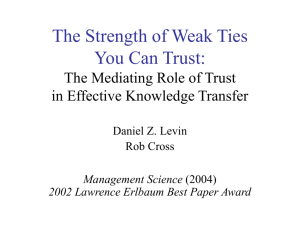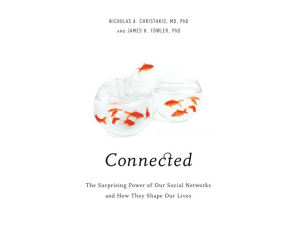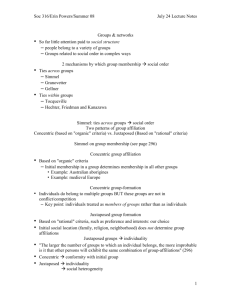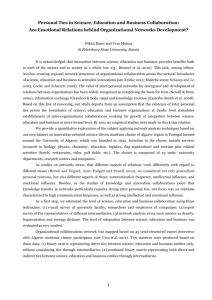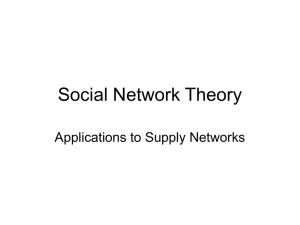A Benchmarking Model for Management of Knowledge
advertisement
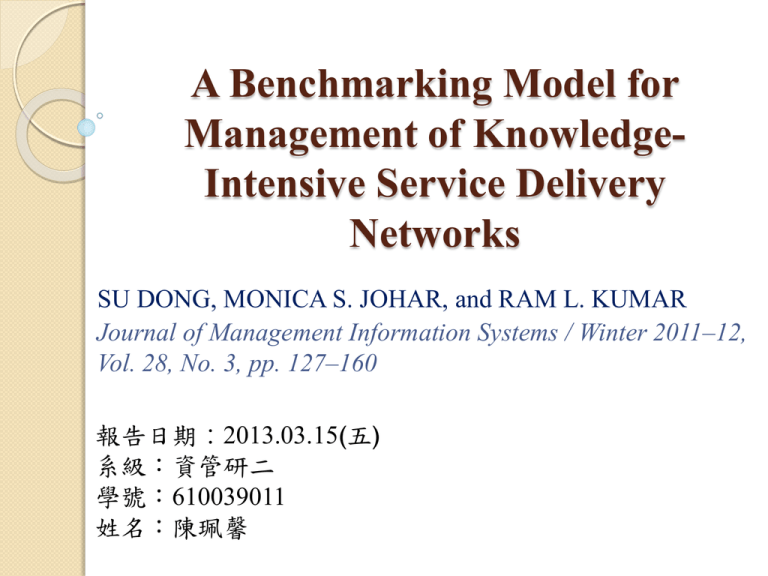
A Benchmarking Model for Management of KnowledgeIntensive Service Delivery Networks SU DONG, MONICA S. JOHAR, and RAM L. KUMAR Journal of Management Information Systems / Winter 2011–12, Vol. 28, No. 3, pp. 127–160 報告日期:2013.03.15(五) 系級:資管研二 學號:610039011 姓名:陳珮馨 Introduction Introduction(1 / 3) Organizations increasingly use knowledgeintensive information technology (IT) and ITenabled services delivered from multiple locations. Employees providing such services may be at different locations and interact with each other to form a knowledge- intensive service delivery network (KISDN). The author define KISDNs as networks of knowledge workers who use their expertise and professional relationships with other experts in an IT-intensive environment to perform knowledgeintensive service tasks. 2 / 33 Introduction(2 / 3) In addition to IT services, KISDNs include other knowledge-intensive services that are facilitated by sophisticated IT such as some types of management services, financial services, and engineering consulting services. It has been recognized that the real benefits of providing these knowledgeintensive services include expert knowledge and problem-solving capability. 3 / 33 Introduction(3 / 3) Research Question: ◦ How are knowledge diffusion and business value affected by workflow decisions, knowledge management decisions, and organizational information networks in KISDNs? 4 / 33 Theoretical Background KISDN and Service Science(1 / 2) This research studies KISDNs, which are service systems with knowledge-intensive service tasks and service-level agreements. Maglio and Spohrer define service science as “the study of service systems which are dynamic value creation co-configurations of resources (people, technology, organizations and information)” and suggest that a service system may be considered a basic theoretical construct for service science. 6 / 33 KISDN and Service Science(2 / 2) The goal of this research is to better understand how people, technology, organization, and shared information can be brought together for dynamic value cocreation. Such a study is consistent with the service science perspective of studying “how service systems interact and evolve in order to create value”. 7 / 33 Social Networking and Knowledge Sharing in Work Processes(1 / 3) 8 / 33 CN RN SN Information diffusion Strong link Direct link random complex Use example Mining e-mail network Knowledgeintensive industries IT-intensive work environments Social Networking and Knowledge Sharing in Work Processes(2 / 3) 9 / 33 In studying KISDNs, we recognize that workers could seek help from co-workers in order to improve their competence. Strong ties occur between workers who know each other directly through organizational relationships that facilitate knowledge sharing. Workers connected by weak ties do not know each other directly but have strong ties with another (intermediate) worker. This intermediate worker plays a bridging role that allows the two workers to get acquainted and share knowledge with each other. Social Networking and Knowledge Sharing in Work Processes(3 / 3) Workers may also consult experts who are listed in the company’s internal directory, and with whom they have no strong or weak ties. Consultation with such an expert is referred to as using a performative tie, since the basis for consultation is job performance (expertise) Workers with strong ties are the most efficient and most likely to provide help 10 / 33 Workflow Decisions, Knowledge Management, and Business Value This research studies the workflow of service tasks in the context of knowledge workers. ◦ These workers can improve competence by consulting co-workers using ties. 11 / 33 The author study how different types of IFNs, density of these networks, workforce characteristics, and service task characteristics affect organizational learning, knowledge retrieval, and overall business value. Model Development Model Development 與IT有關, 像是DBM, programming 非立即處理, 會造成成本 Request 對企業價值造成負面影響 13 / 33 Model Formulation(1 / 4) 希望在這段 時間中能達到 企業價值最大化 support 14 / 33 一項任務完成所需的時間 以及閒置工作者從閒置到 完成工作所需時間 Model Formulation(2 / 4) 員工薪水 技能強度: 0:專家 4:新手 工作者使用 技能在t時間段 完成工作的效率 15 / 33 Model Formulation(3 / 4) 工作者k總共 可獲得的知識 16 / 33 Model Formulation(4 / 4) 工作者分配到的任務量 以及任務收益 工作者閒置的成本 17 / 33 KISDN最佳化 任務從執行到完成所需 的總成本 未分派任務所造成的成本 Simulation Design Simulation Design : making assignments in periods t and t + 1 successively : waiting and making assignments only in period t + 1 : wait for one period 19 / 33 Simulation Parameters(1 / 2) 1200時間區間 小組織 讓顧客等待所造成的成本 閒置員工的薪資成本比例 閒置員工的係數 使用S技能完成工作K 員工薪資 20 / 33 Simulation Parameters(2 / 2) 任務類型 閒置員工從閒置到 完成工作的時間 Equal arrival rate Knowledge retention coefficient 提供幫助的個體成本 向外求助 21 / 33 Simulation Results Impact of Network Topology and Density(1 / 4) Financial performance 23 / 33 Operational performance Impact of Network Topology and Density(2 / 4) These results are driven by knowledge-sharing behavior, which in turn depends on network topology and network density. The extent of knowledge exchange between two coworkers depends on the type of tie shared and the competence difference between them. Since strong ties are the most effective means of acquiring knowledge, this accounts for improved financial and operational performance with increase in network density. As network density increases to relatively high values, the three network topologies tend to become similar, reducing performance differences between them. 24 / 33 Impact of Network Topology and Density(3 / 4) good 25 / 33 Impact of Network Topology and Density(4 / 4) 26 / 33 Impact of Cost of Providing Help on Relative Network Performance 27 / 33 Effect of Various Parameters on Assignment Decision Dynamics 28 / 33 Model Extension: Impact of Training on Knowledge Acquisition 29 / 33 Conclusions Conclusions(1 / 3) In author’s opinion, managing KISDNs is an important aspect of the emerging discipline of service science, which is of increasing interest to IS researchers. To the best of author’s knowledge, author’s paper is the first to propose how IFN structure information can be combined with worker competence information to improve operational and financial performance of KISDNs. 31 / 33 Conclusions(2 / 3) 32 / 33 Future research could examine interdependent task arrivals, for example, by extending the unit of analysis in this paper (a single KISDN) to multiple interrelated KISDNs. Author’s focus in this paper has been on maximizing value. However, organizations might be interested in other objectives such as maximizing knowledge sharing for future use. Alternative model formulations to study this are interesting areas of future research. Conclusions(3 / 3) 33 / 33 This paper will serve as useful initial framework for IS researchers as well as practitioners interested in exploring this nexus or its components in a service science context. Thank you!!
